Nothing is certain, except for a PR crisis. At a time when crises arise on all sides - from your company actions to TikTok challenges - formulating crisis management strategies in public relations is a must.
Until you can prevent all public relations crises, you can - and should - prepare for them in advance.
Try Prowly's media monitoring free for 7 days
Start tracking your brand and keywords for free (no credit card required) in Prowly.
- Comprehensive monitoring: Track the web, social media, print, and broadcast mentions
- Transparent pricing: Plans start at $258/month
- All-in-one platform: Get everything you need in one tool for PR, incl. media database, outreach, reporting, and more
What is PR Crisis Management?
PR crisis management is an organizational strategy to manage and mitigate unexpected events that pose a threat to the reputation or survival of a company.
This approach focuses on thorough planning to promptly and efficiently respond to any crisis that could impact the company's image or stakeholder relationships.
Ultimately, the effectiveness of PR crisis management is gauged by how well a crisis is handled, how swiftly the company recovers, and how the crisis impacts long-term trust and relationships with stakeholders.
Usually, brands plan ahead with PR crisis management strategies, which define:
- what potentially harmful situations look like
- what steps should be taken (and by whom)
- how to handle the media during a crisis
- and what to do after the crisis has been managed
Crisis Prevention: The Real Game-Changer in PR Crisis Management
Identifying Hidden Vulnerabilities
Most brands focus on external risks - negative press, social media backlash, or customer complaints. But the real threats often come from within. Weak internal policies, poor leadership decisions, and unmonitored employee behavior can trigger PR disasters. Conduct regular audits to identify blind spots before they explode.
Monitoring & Sentiment Analysis: Staying Ahead of the Storm
A crisis doesn’t start when the media reports it, but starts when warning signs go unnoticed. Investing in real-time brand monitoring and sentiment analysis can alert you to emerging problems. Track customer sentiment, competitor narratives, and industry shifts to detect early indicators of trouble.
Pre-Crisis Communication Playbook
A well-structured crisis communication plan can be the difference between swift recovery and prolonged fallout. This should include:
- Pre-approved messaging templates for different scenarios
- Designated spokespersons trained in crisis communication
- A rapid response team with clear roles and decision-making authority
- Internal and external communication protocols
Spot a PR crisis in time
The first rule of crisis management in PR: the sooner you know, the better.
Learn our methods of spotting upcoming trouble.
1. Monitor mentions around your brand
If you haven't already started media monitoring, it's high time you did. Why?
You can learn what journalists and social media users say about your brand or the topics you care about in real-time. It's the single biggest reason to use media monitoring. With this intel, you can react appropriately and promptly, which is crucial in PR crisis prevention.
The immediate nature of alerts helps you find out about potential threats and tackle them before the media, your stakeholders, or your client base becomes concerned.
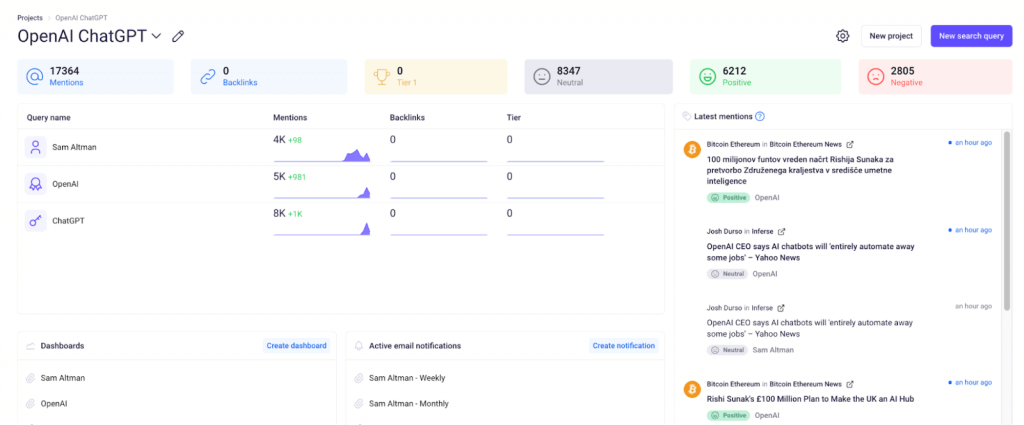
Of course, media monitoring proves insightful all the time. When the situation is stable, you can use it to measure your PR results, like earned media. It also shows you potential new initiatives or cooperation opportunities.
Media monitoring gives you an understanding of what makes up the usual level of noise. With these numbers in hand, you can easily assess what changes should concern you.
→ Interested in diving into the details? Read our Media Mentions Guide.
2. Use media monitoring tools to prevent a PR crisis
You don't have to scroll through the internet in search of media mentions to analyze. Tools like Media Monitoring do it for you, and even add more information, like sentiment, estimated reach, and context.
You can get real-time notifications about the content. Even before it appears on Google search.

Prowly AI helps identify the context of each press hit so you can filter the results and get only those that are relevant to you.
There are some free tools for brand monitoring, like Google Alerts, but they can provide you with inaccurate and outdated mentions. For professional purposes, and especially in PR crisis prevention, you should definitely choose Google Alerts alternatives and limit the drawbacks.
3. Implement a social listening tool
Currently, there's a high chance of a PR crisis coming from social media. That's why your audience might be the first to spot a problem, way before it crosses your team’s radar.
With proper social listening tools, you can prevent an escalation in time. This can even save the company's bottom line, as it can be vulnerable to an untreated PR crisis.
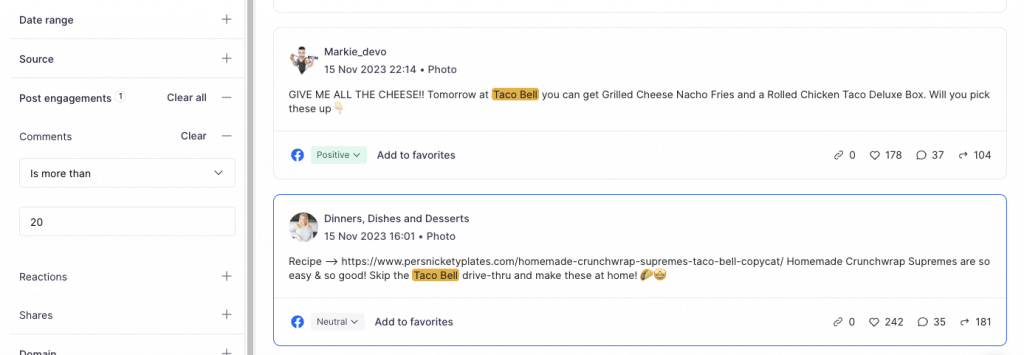
Prowly's Social Listening tool gives a wide range of options, helpful in PR crisis prevention. It can help you understand how your audience feels about your brand. Also, you can gain insights into countries and languages where you have the highest engagement.
All of this helps you make decisions based on real data, instead of a gut feeling.
Noticing a sudden drop in sentiment and a peak in mentions' number? That might be one of the first signs of a PR crisis on the rise.

P.S. Check out this guide on social media crisis management to fine-tune your strategy with a few practical tips.
Pay attention to the volume of mentions
The volume of mentions will naturally rise and fall, all depending on your PR activities, marketing, and other factors. With media monitoring in place, you can set up your baseline — the normal or expected amount of chatter.
Then an unexpected rise in volume certainly won't leave you indifferent. It can be due either to a sudden earned media success, or the alarm to man PR crisis prevention stations. Together with sentiment analysis, they can keep you informed on how to react.
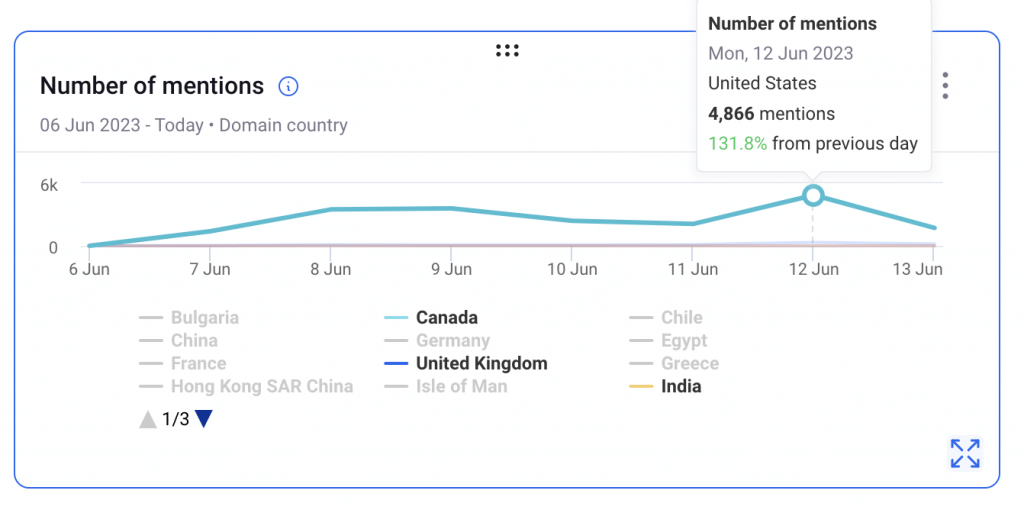
Use filters to focus on valuable mentions
Not all mentions bring value — especially if you track popular or generic keywords. Prowly's tool lets you filter the results and show only what's interesting for you. So you can save time on extracting the signal from the noise.
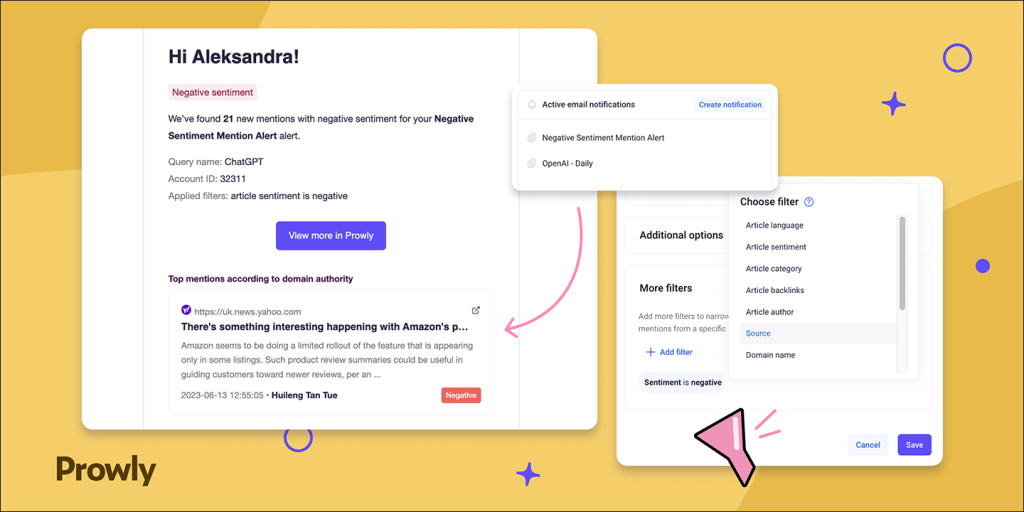
You can set various types of filters, like date range, article language, domain country, domain relevance, and sentiment. Group them together to get to the specific media mentions you need.
Set up alerts
Get email notifications for chosen types of mentions. You can choose what situations need your immediate attention. With alerts, you can react quicker and put out a fire before it spreads.
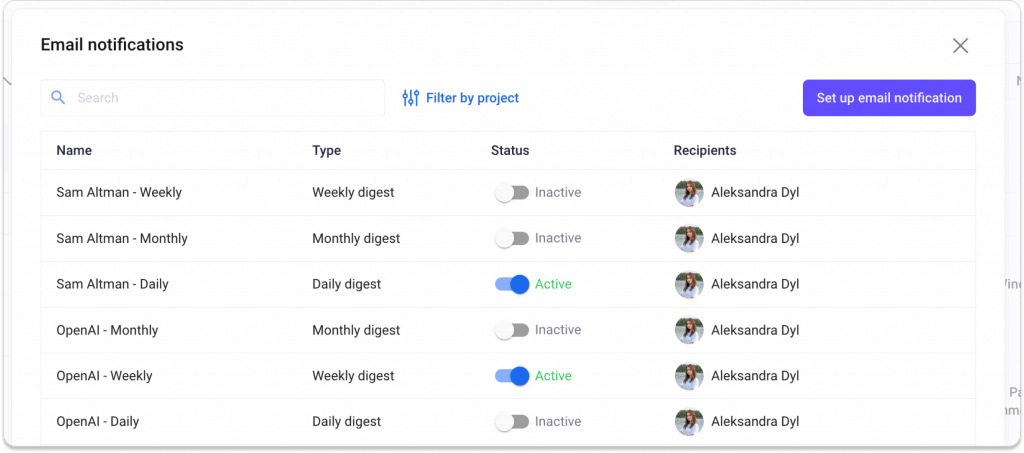
You can set up various alerts and choose who should get them. For example, your communication front line can be notified about negative sentiment mentions so that they can quickly assess a situation as it arises.
Create reports for crisis management
Using technology in Public Relations results in a lot of numbers. And you can use reports to showcase the impact of your work. This way, you'll be able to better communicate the value of your work to the board.
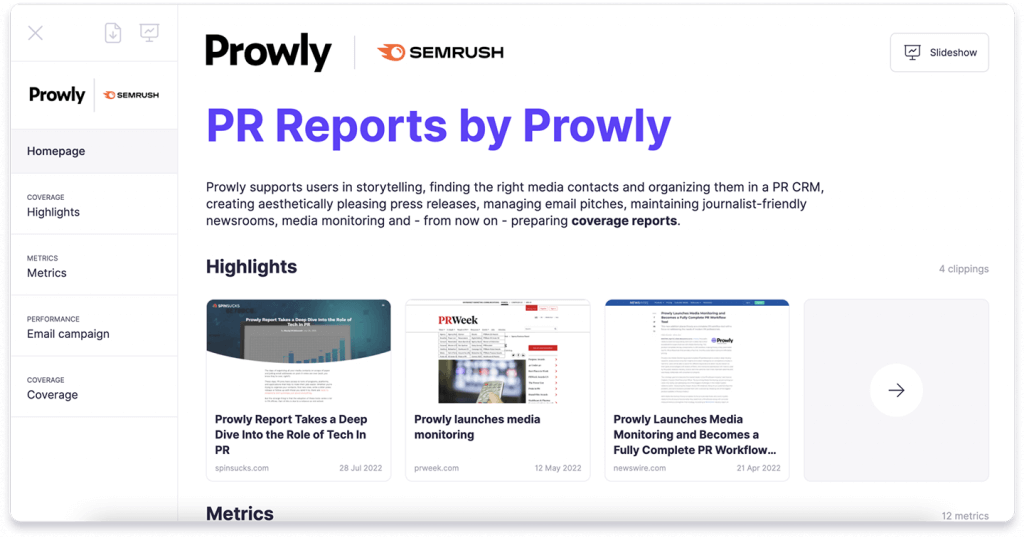
The reporting feature helps you organize mentions, show their estimated reach and views, and translate them into reliable metrics.
Showing relevant data is especially useful once you educate your stakeholders. If you need to explain to them why it is so important to have a PR specialist on board a crisis team, the numbers can help get your point across.
Insights you gather in a clear, easy-to-digest format will definitely help you prepare for an upcoming PR crisis. They are invaluable in assessing the efficiency of your strategies. With reports, you don't have to go through each situation in detail - just the crucial information.
Keep an eye on your competition
You could limit your monitoring to your brand or go beyond and observe your competition.
If your competitor faces a PR crisis, you'll be able to assess the situation and make sure it doesn't impact your business. Also, you can analyze their reactions and draw insights for future use.
How to handle a PR crisis
It all starts with preparation. Here’s how to manage a PR crisis:
Step 1. Identify potential crisis triggers
This helps you spot potential problems sooner. If you notice a trigger, you can observe how the situation develops and adjust your response.
Potential crisis triggers can be:
- New challenges faced by your competitors or the industry in general
- A PR crisis of one of your competitors
- A negative review of your business
- Mismatched marketing communication
- An executive scandal
- Harassment or discrimination testimonials
Classify the triggers to quickly assess how serious the situation can be.
Step 2. Prepare procedures for PR crises
Adjust your plan of action to how severe the situation is, as one of the crucial rules claims: don't overreact. Your reaction is also crucial in calming (or worsening) a PR crisis. Putting more effort into putting out a fire than is necessary gives the impression that there is something more to hide.
Come up with a few procedures to follow. They can quicken your reaction time.
Specifically, you’ll want to establish:
- Who is the first response line
- Who makes up the crisis PR strategy team
- What type of media you use to reply
- When it should be escalated
If the situation can seriously threaten your company, make sure the public relations and crisis management teams cooperate. As you'll have to work on the unified message you send out to the public, having at least one PR specialist on board is a must.
Step 3. Craft a crisis response strategy
When a crisis hits, you don't have much time to come up with your first words from scratch. A few versatile forms of addressing the problem should be prepared in advance. You can opt for a press release, social media posts, video statements, or blog posts.
In PR crisis management, an effective emergency response to negative publicity includes:
- Reassurance
- Transparency
- An appropriate, respectful tone
Make sure to highlight that you're investigating the situation. Show that you care and respect your clients and stakeholders, and above all treat the issue seriously.
Your quick reaction can show you have control over the situation and gives you time for a more detailed response, and that's gold in crisis PR management.
Later, when you know more about the situation, a press release or more advanced content forms are definitely your go-to tool. Check out our crisis press release examples and see how to craft your own.
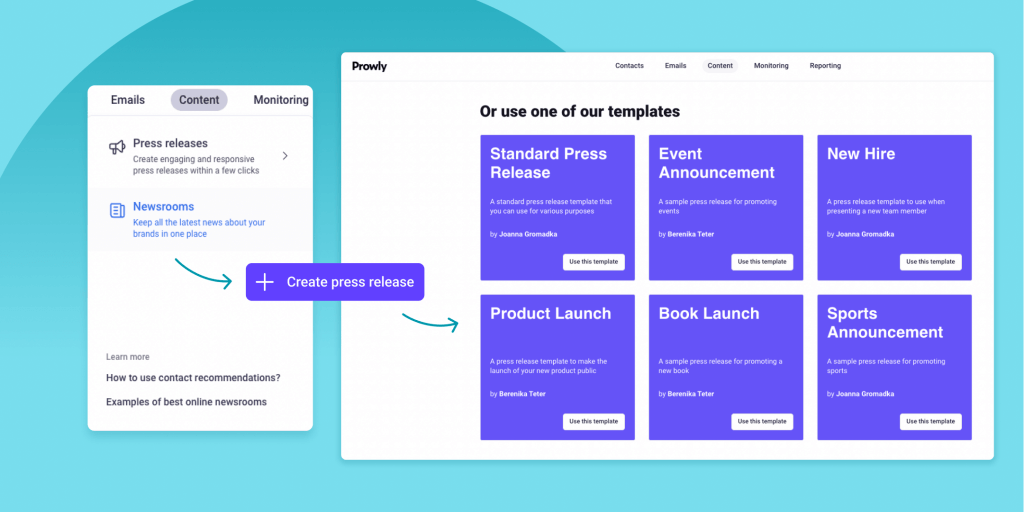
Revise your actions after each PR crisis
Learning from real-life situations plays a huge part in PR (and crisis) management. Make sure to assess the efficiency of your PR strategies for crisis management and build them up with new insights as you gain them.
Of course, it'd be best to do it after each PR crisis you spot in your industry. Potentially, you may face similar issues as your competitors, and the audiences’ reactions can guide you in improving your messaging.
Implement helpful technology
PR tools like Prowly help you in efficient media crisis management at all stages of a PR crisis:
- Media Monitoring helps to spot incoming crises and tracks how they develop over time.
- Media Database provides access to over 1 million contacts and helps you build targeted media lists and pitch your side of the story with a personalized message.
- Online Newsroom and Press Release Creator give you the tools to share your narrative and respond to a crisis.
- PR Reports let you analyze the numbers and assess the final impact.
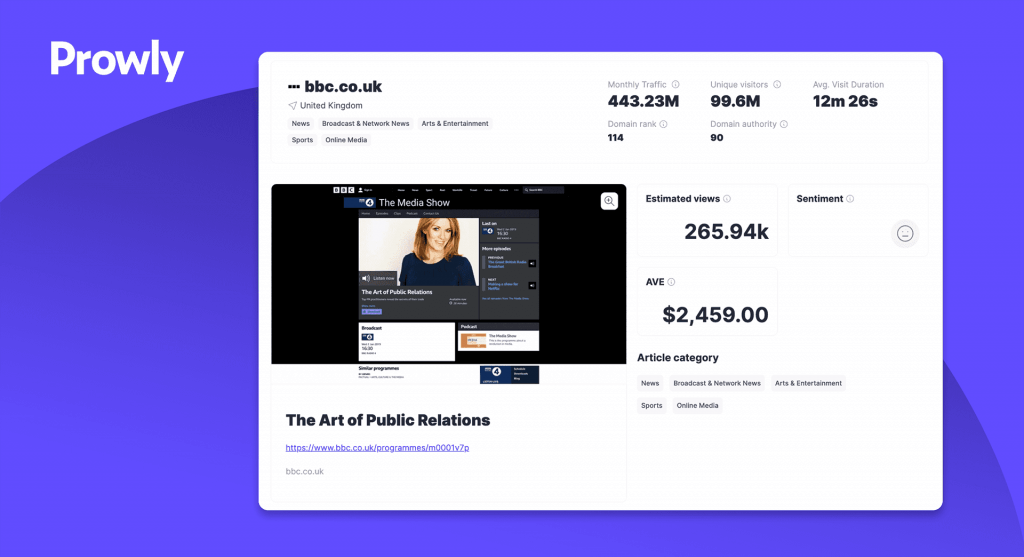
Good PR Crisis Management Examples
The best way to learn is from real-life PR crisis examples, and believe me: when it comes to this topic, it's a never-ending story.
That's why we’ve collected some recent PR crisis examples — both good and bad. Read our analysis and give it some thought. What would you do in such situations?
Let's start with one of the best crisis management examples:
PR crisis management example #1. Slack
Imagine losing access to your company's main communication tool — for 5 hours. That's what happened to Slack users back in 2022.
The company faced the challenge with transparency, keeping their users updated. They even spoke openly about the errors they made in the process. Finally, a sincere apology (with a bit of the sense of humor well known in their overall messaging), made a perfect finish to the crisis.

Slack kept the trust of its users with transparency and honesty. They owned their errors and made sure their users were informed about their progress.
PR crisis management example #2. Aldi's #freeCuthbert
What is an example of good crisis management? Aldi can certainly share some insights.
Back in 2021, M&S, a UK-based food store chain, called their competitor, Aldi, to court. The reason? Aldi's caterpillar cake, Cuthbert, seemed to bear a resemblance to M&S’s version, Colin. If M&S had succeeded in court, it would have had severe consequences - and have caused a huge PR crisis.
And what was Aldi's reaction?
Together with their agency, McCann Manchester, they held a brilliant social media campaign which aimed to win people's hearts. It all started with a simple tweet:
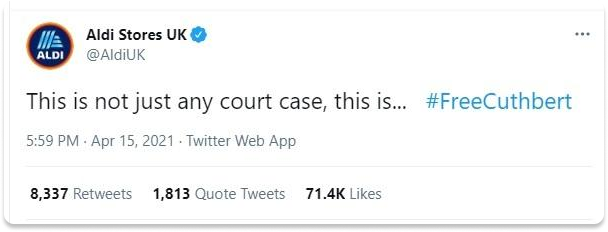
Their entire campaign consisted of about 20 posts, published on Twitter and Facebook for around a week.
And the results were impressive:

They were featured in the media (gaining around £5m in earned media), and significantly increased their followers and social engagement rate. #freeCuthbert was the most popular hashtag on Twitter… twice. People started to make memes and widely used the hashtag.

Also, the entire situation changed the news’ sentiment (Aldi +8.5%, M&S -134%), as well as purchase consideration (Aldi +6.1%, M&S -15.3%). Those are serious numbers that impacted both businesses' bottom lines.
Aldi went further, calling all supermarkets to donate money to cancer foundations - with a new campaign, #caterpillarsForCancer. Cuthbert is still present in their marketing actions, being a big part of their company easter eggs.
The campaign not only turned the PR crisis into a massive win. It even took the Grand Prix at The Drum Award for Social Media, and another Grand Prix at Eurobest Awards in the category of "Influencers and Social."
PR crisis management example #3. Burger King
Brands are getting increasingly more engaged in social issues, especially on dates like International Women's Day. It can be either successful, shedding light on the cause by raising controversy, or a disaster.
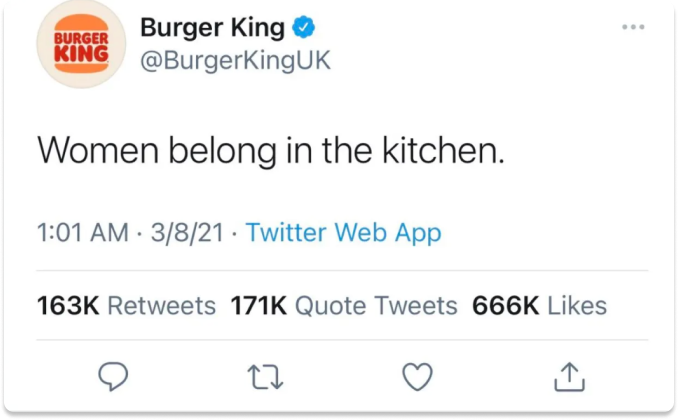
Taking a harmful statement and trying to give it a new meaning was a bold decision. In this case, Burger King made the wrong call and provoked their own PR crisis.
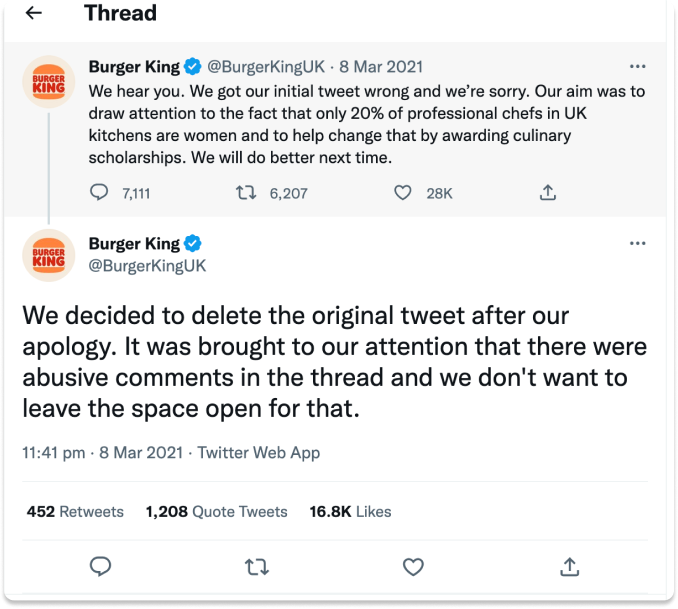
What was Burger King's Public Relations response to the crisis? The company owned their misjudgment and sincerely apologized. Pro tip, there's no place for "To all those who felt offended, I want to apologize." They proceeded with showing the aim of the campaign, which was in helping women pursue their dreams of becoming professional chefs.
Also, they explained their decision to delete the original tweet. As the team claimed, comments that appeared in the following thread were abusive and they didn't want to allow them. Without this context, it might have been seen as an attempt to clean up their image and pretend that nothing happened.
Best PR crisis management examples: a wrap-up
Let's summarize the most important take-aways:
⬛ The golden rule is transparency and owning your mistakes. This alongside acknowledging the feelings of your audience helps maintain their trust.
⬛ Even when you're hit by a crisis, PR communication allows some space for humor. Make sure to choose the appropriate moment, though, like Slack - they only became humorous again after solving the problem. Also, it needs to keep in line with your brand voice.
⬛ The last point is, don't forget about giving legitimate reasons for the company's decisions. Burger King deleting the original tweet without explanation would garner more criticism, not praise.
In the best crisis management examples you can spot a common thread of transparency. Even Aldi, with its playful campaign, didn't run away from the fact that it was sued for their cake’s similarities.
P.S. Here’s an article that might come in handy if you’re looking for a tool to measure the impact of your communication efforts.
Bad crisis management examples
Let's go through some cases where crisis management in PR heavily and negatively impacted the company:
PR crisis management example #1. Silicon Valley Bank
This might be the first bank run fueled by social media - a media crisis example to learn from.
The SVB specialized in tech sector financing. With the boom for tech companies that arose with the pandemic, it became the 16th biggest bank in the U.S. and provided financing for about half of all U.S. venture-backed technology and healthcare companies.
Nevertheless, inflation and poor managerial decisions caused a drop in the bank's portfolio value.
On March 8, it started to sell its bonds at a loss to gain capital. As a result, people became alarmed that their money wasn't secure. They started withdrawing it, and a wildfire spread across Twitter and WhatsApp, inducing panic.
As a result, the next day SVB's stock plummeted by 60% and, on March 10, it collapsed.
The relationship between the Twitter noise and the bank’s stock price decrease was confirmed on a larger scale by experts at The Conversation. Their research shows how impactful social media can be - up to the point of predicting a banks' destabilization. And, as the SVB example shows, it can even lead to bankruptcy.
PR crisis management example #2. Twitter becoming X
What is an example of a PR crisis in 2023? Twitter, under the lead of Elon Musk, certainly had its share. But we'll focus now on their rebranding. Twitter was renamed to X — the everything app, which would include payments, video streaming, and e-commerce.
What caused the problem?

First of all, the rush. When the rebranding was announced, the company visibly wasn't ready for it. From a lack of changes in copy to issues with the domain name, it added up to a quickly diminishing trust.
What's more, it was an attempt to eradicate a well-known name, which had grown into everyday language. People still tweet their tweets even now, instead of x-ing their x-es. With Twitter traces still visible in the service, the X name has a long way to go before it can ever Twitter.
Musk also (famously) used Twitter (errr, X) polls to make the final calls on rebranding, like setting the default platform color to black. As you can see on the tweet date, it was posted soon before the rebranding was announced.

This chaotic rebranding communication is only a part of what was a somewhat dubious attempt at media crisis management. Public Relations experts shared their insights with Forbes, talking about how Musk's actions contributed to the Twitter crisis.
PR crisis management example #3. Ticketmaster vs Swifties battle
Taylor Swift definitely has one of the biggest and most active fan bases in the world — and Ticketmaster, a ticker vendor site, faced their anger. Imagine: you're a die-hard fan who can't get tickets to her first tour in years.
And that's exactly what happened.
Ticketmaster kicked off the sign-up process for their Verified Fan presale, giving Swifties the opportunity to get their tickets ahead of the crowd. Its aim was to exclude bots and smooth out the buying process.
Yet, there arose the first problem. When the presale was about to start, they randomly handed out presale codes to 1.5 million fans, leaving a whopping 2 million registered Swifties out in the cold. Nevertheless, the site was hit by over 14 million visitors.

As you can imagine, the servers couldn’t manage the load.
Even fans who got the code couldn't buy tickets, yet at the same time, bots began to appear on the site. This proved that the Ticketmaster system was not prepared for the flood, and was still vulnerable to bots.
Finally, there weren't enough tickets left for a public sale, which was eventually canceled. Tons of fans ended up without the possibility of buying a ticket. What's worse? Tickets available on resale platforms reached prices of up to several thousand dollars.
Swift herself published a statement where she expressed disappointment, comparing the buying process to going through "several bear attacks."
The issue led fans and the ticket platform to court, boosting the discussion about Ticketmaster’s monopoly. The case was even tackled (again) by the U.S. Congress.
As for Ticketmaster and their reaction, they committed various mistakes along the way.
When the problem appeared, they didn't opt for proactive communication, leaving most of the fans uncertain. They also didn't comment on any actions they would take to alleviate the problem.

Their tweet about canceling the tour sale lacked any form of acknowledging their fault, pushing it on "extraordinarily high demands." As Swift stated, she and her team insisted on ensuring that the service would meet the spike, which is contradictory to Ticketmaster’s own words.
Later, they re-published a previously deleted statement with slight edits and added an apology. The first version worsened the audience's reaction and finally got taken down from the company's website.
A lack of transparency and accountability fueled the development of the PR crisis it had to face.
Worst crisis management examples: a wrap-up
Let's sum up these PR disasters with three takeaways.
⬛ The major mistake is chaotic communication - or its lack. In difficult times, each word is assessed by everyone involved. Your choice (even to remain silent) weighs heavily on how a crisis evolves.
⬛ Furthermore, a lack of ownership which contradicts the basic PR rules of an effective apology. These classic rules can guide you on how to approach common situations. Finally, they help get you out of a brand reputation crisis.
In all of the above examples, we have to acknowledge the impact of social media. It seems obvious and well-worn already, but the consequences we saw in 2023 - as serious as taking down a bank - have to be respected.
Key takeaways: effective PR crisis management
PR teams have an increasingly more challenging task. Firstly, companies (and their leaders) are sending out more communication all the time, so the chance of missing the mark continues to rise. At the same time, anyone can reply and start a fire. In this environment, the way you handle it can make or break (or at least damage) your company.
Remember the stages of crisis management in public relations: preparation, damage assessment, take action, and analysis.
The most important part of managing any PR crisis is preparation. Think about the problems you could face and plan ahead with possible solutions. They can prove invaluable when time literally becomes money.
Proper technology helps you face any PR crisis more effectively. Prowly proves useful not only in times of PR crisis, it covers your entire PR workflow: with media pitching, an online newsroom, and press release creator.
Sounds interesting? Give it a try for 7 days for free.

